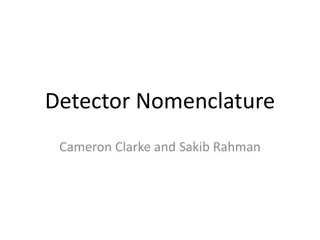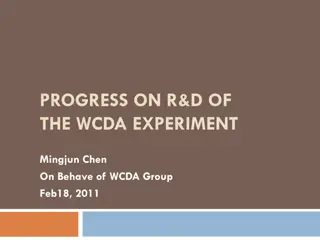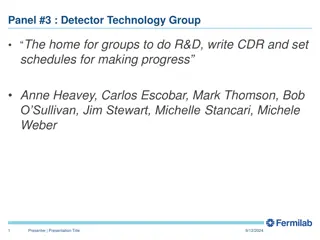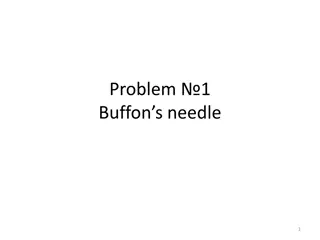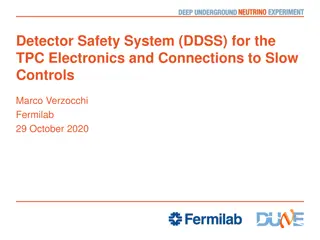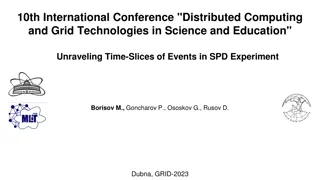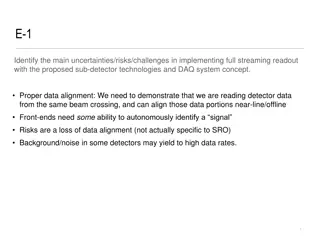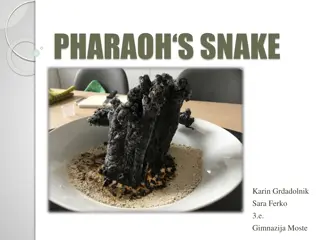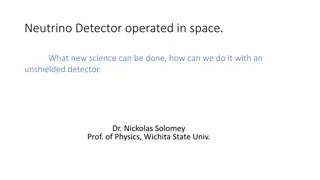Understanding Detector Response in SIDIS He3 Experiment
Introduction to analyzing hit and occupancy rates from different particle sources in the SIDIS He3 experiment. Explore the simulation data to determine event rates based on detector channels. Examples include pi0 sources and eDIS from the target. Various occupancy cuts are applied, and thresholds are set for different detector components to study particle interactions effectively.
Download Presentation

Please find below an Image/Link to download the presentation.
The content on the website is provided AS IS for your information and personal use only. It may not be sold, licensed, or shared on other websites without obtaining consent from the author. Download presentation by click this link. If you encounter any issues during the download, it is possible that the publisher has removed the file from their server.
E N D
Presentation Transcript
SoLID SIDIS_He3 Hit and Occupancy Zhiwen Zhao 2017/04/26
Introduction Hit , look at detector response from different source particles to get hit rate Occupancy , assume certain threshold cut on hit information to get event rate We look at each detector channels (no GEM or MRPC yet) We assume each particle entering a detector is independent, so no time window for integration yet Simulation data of SIDIS_He3_JLAB_VERSION_1.3/pass7 is used
Some sources as example Look at only source from pi0, eDIS from target
SIDIS_He3, gas (e DIS) N_p.e. > 1 for occupancy
SIDIS_He3, gas (e DIS) N_p.e. > 0 for occupancy
SIDIS_He3, gas (pi0) N_p.e. > 1 for occupancy
SIDIS_He3, gas (pi0) N_p.e. > 0 for occupancy
SIDIS_He3, gas (e DIS) Occupancy cut, preshower>0.4MeV, shower>6MeV
SIDIS_He3, gas (pi0) Occupancy cut, preshower>0.4MeV, shower>6MeV
All source all source from target and windows BeamOnTarget, BeamOnTargetEM by Geant4 eDIS, pions and proton from target by HallD pions and proton from windows by Wiser Occupancy threshold cut (low) LGC > 0 N of p.e. HGC > 0 N of p.e. SPD_FA > 0.1MeV (1/5 of trigger cut 0.5MeV) SPD_LA > 0.3MeV (1/5 of trigger cut 1.5MeV) EC preshower > 0.4MeV EC shower > 6MeV Occupancy threshold cut (high) LGC > 1 N of p.e. HGC > 1 N of p.e. SPD_FA > 0.25MeV (1/2 of trigger cut 0.5MeV) SPD_LA > 0.75MeV (1/2 of trigger cut 1.5MeV) EC preshower > 0.8MeV EC shower > 12MeV
LGC and HGC Occupancy cut (low), LGC > 0 N of p.e. HGC > 0 N of p.e.
LGC and HGC Occupancy cut (high), LGC > 1 N of p.e. HGC > 1 N of p.e.
SPD Occupancy cut (low), FA > 0.1 MeV, LA > 0.3 MeV
SPD Occupancy cut (high), FA > 0.25 MeV, LA > 0.75 MeV
EC Occupancy cut (low), preshower > 0.4 MeV, shower > 6 MeV
EC Occupancy cut (high), preshower > 0.8 MeV, shower > 12 MeV
Occupancy Result: LGC and HGC The table shows For LGC: sum of 9 channels For HGC: sum of 16 channels Occ(kHz) BeamOn Target BeamOn TargetEM Pi0 Halld gas Pi0 Wiser win up Pi0 Wiser win down eDIS Halld gas eDIS Wiser win up eDIS Wiser win down LGC (>0) 2370 1332 293 281 560 30 19 3 LGC (>1) 1064 464 143 117 240 20 7 2 HGC (>0) 1510 1460 18 26 30 15 17 1 HGC (>1) 1010 943 14 19 23 10 12 1 For LGC, EM and hadron contribute half and half For HGC, EM is dominating
Occupancy Result: SPD The table shows For SPD_FA: sum of 240 channels For SPD_LA: sum of 60 channels Occ(kHz) BeamOnTarget BeamOnTargetEM SPD_FA (>0.1) 1.35e6 1.23e6 SPD_FA (>0.25) 1.01e6 0.92e6 SPD_LA (>0.3) 2.67e6 2.43e6 SPD_LA (>0.75) 1.38e6 1.24e6 For SPD, EM is dominating
Occupancy Result: EC The table shows For EC_FA: sum of ~1300 channels For EC_LA: sum of ~500 channels Occ(kHz) BeamOnTarget BeamOnTargetEM EC_preshower_FA (>0.4) 1.79e6 1.62e6 EC_preshower_FA (>0.8) 1.27e6 1.16e6 EC_shower_FA (>6) 5.16e5 4.11e5 EC_shower_FA (>12) 1.39e5 0.72e5 EC_preshower_LA (>0.4) 1.25e6 1.11e6 EC_preshower_LA (>0.8) 0.81e6 0.71e6 EC_shower_LA (>6) 2.41e5 1.24e5 EC_shower_LA (>12) 0.91e5 0.11e5 For shower, EM and hadron contribute half and half For preshower, EM is dominating
Result Summary A All values from BeamOnTarget Max Occ(kHz/c hannel) low cut Max Occ(kHz/c hannel) high cut Average Occ(kHz/c hannel) low cut Average Occ(kHz/c hannel) high cut Number of channel Total Occ(kHz) low cut Total Occ(kHz) high cut LGC 411 190 263 118 270 71e3 32e3 HGC 120 83 94 63 480 45e3 30e3 SPD_FA 8.6e3 6.3e3 5.6e3 4.2e3 240 1.35e6 1.01e6 SPD_LA 45.6e3 23e3 44.5e3 23e3 60 2.67e6 1.38e6 EC_presho wer_FA 4373 3312 1380 980 ~1300 1.79e6 1.27e6 EC_showe r_FA 3153 920 400 110 ~1300 5.16e5 1.39e5 EC_presho wer_LA 6644 4533 2500 1620 ~500 1.25e6 0.81e6 EC_showe r_LA 3415 825 482 182 ~500 2.41e5 0.91e5 Total 4650 7.9e6 4.6e6
Result Summary B All values from BeamOnTarget Max Occ(kHz/c hannel) Average Occ(kHz/c hannel) low cut Number of channel Total Occ(kHz) GEM 1 906*30 GEM 2 1020*30 GEM 3 1166*30 GEM 4 1404*30 GEM 5 1040*30 GEM 6 1280*30 MRPC 893 33*50*2 2.95e6 Total 207780
Other thoughts So far all hit rates and particles rate are based on detector response from individual particles. Some detector like SPD and EC have high rate. There are many particles entering them within their integration time windows. If we consider this, the hit rate, occupancy cut value, occupancy rate could be different




